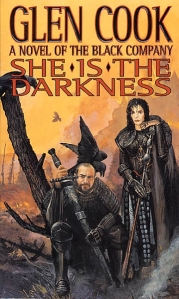Good evening Ladies and Gentlemen ! Bonsoir Mesdames et Messieurs ! Welcome back on board of I. S. S. Rover. This is your captain speaking. It is some 15 – 17 °C out there, we have a clear sky, so strap in, as we are about to take off. As for the destination: it´s Khatovar. We are getting nearer and nearer to this “somewhat” legendary place. So, welcome back to the (re)read of the Black Company series as we continue with She is the Darkness. But before I go straight to discussing the matters let me repeat the usual disclaimer.
This is a (re)read of the series that will encompass the better part of the year as I will be reading one book per month. I will be exploring the world of Khatovar, and as this is at least partly a reread there might be spoilers, so continue reading at your own risk, I did warn you. For the previous posts look up the links included at the end of this one.
And now that we have cleared that out of our way lets see what we got here. I have to mention the cover art of the actual book again: does that figure on the cover look like Michael Jackson to you too. I can´t decide whether it´s awesome, or terrible, but I can´t unsee it, it might haunt me for a while, or maybe not. Who knows ?!
But lets return to Croaker and Co. When we last saw them they were preparing to leave for the Shadowlands to start Croaker´s winter campaign against Longshadow. And they finally get rolling. Murgen is still in charge of the Annals, so no changes here. And Goblin is leading a merry band of commandos behind the enemy lines.
After what seemed a somewhat static recollection of past events in Bleak Seasons now everything starts moving toward a conclusion. But not too fast. First we have a battle at Charandraprash pass against Mogaba´s and Blade´s united forces, but to a not big surprise of mine Blade pulls out his forces and surrenders to Croaker. What ? Croaker greats Blade as an old friend. Yeah, my dear readers the whole Blade changing sides thing was a ruse planned by Croaker and performed by Blade to his utter delight as he got to confront the religious fanatics he so much hates, and that helped also Croaker as he got rid of a large part of his taglian opposition and kept them busy elsewhere while he was getting ready for the final showdown with the enemy´s main camp. Ohh, so Croaker isn´t actually such a bad general after all. Hurrah for Croaker !
And Mogaba didn´t expect it, he couldn´t see it coming. He wouldn´t think Croaker capable of such a plan, decision. So Mogaba shortened for one third of the total shadowland forces can hardly keep up against the pressure of taglian onslaught and collapses. The battle at Charandaprash is won, and the Black Company and the accompanying taglian forces start their long haul to Overlook, which is slowed down by Mogaba´s rearguard actions. The partisan warfare is being fought long after the main forces crossed the mountains of Danda Presh. Goblins motley crew is hunting Mogaba. And meanwhile Croaker, Lady and Co. start the long siege of Overlook.
It is everything you desire for in a military fiction. You get elaborate commando actions on both fighting sides, the soldiers are getting restless and bored as they are bogged down in one place for a long time. And this gives a chance to flash out some other details beside the siege. It gets revealed that Lady has somehow latched onto Kina and steals (?) her powers to restore her own magic powers, and abilities. The Nyueng Bao are behaving rather mysteriously, Father Doj exceptionally so. It is revealed that he is trying to find Soulcatcher – the favourite military advisor of our dear bad ass commander in chief, Croaker – as she has stolen a magical artifact belonging to the Nyueng Bao. And this artifact might have a part in the future events.
And as the siege drags on at one moment the things suddenly speed up. Soulcatcher wasn´t aiding just our favourite, Croaker, but was scheming with Radisha to turn against the Black Company: in Taglios the sympathizers of the Black Companny are arrested, in the camp at Overlook Prahbindrah tries to disarm Lady´s forces, but fails. In the end the Black Company ends up with Howler, Longshadow, Narayan Singh and Prahbindrah as their prisoners, and Soulcatcher escapes with the Daughter of the night.
And also our favourite cowardly wizard awakens after an extended “sleep”, not that it matters much as Murgen develops an ability to wander around the world in his dreams as a side effect due to “ghostwalking” with Smoke. And this development brings one of the brighter moments of the series: Murgen realizes that his wife Sarie is alive and pregnant; a light of hope.
But back to Company business. As the Black Company is now pressed from north by their former allies, Croaker decides to take the final step and lead the company to the Khatovar. A dream gets fulfilled finally. Or does it ?!
Soulcatcher sprangs her final trap, and half of the Company is trapped inside the halls of Khatovar, the other half on run back to Overlook. And the leadership of the Black Company: Croaker, Lady, Blade and some more are trapped in a stasis in the cave of the old man Murgen used to see in his dreams. Only Murgen escaped this treatment as he was dreamwalking at the time Soulcatcher trapped the rest of them.
Croaker, Lady and Co. trapped and helpless in an unknown place, with Soulcatcher roaming free, it seems an appropriate end to the series. Soulcatcher finally won, has had her revenge, seemingly taken everything from her sister. But we know that it´s not the end yet, as there are two more books in the series ( and another two coming in the following years – editor´s note ). But I do ask myself: did Cook intend to finish the series here ? Or was it just a joke on the readers ? I mean it is a perfect ending: the “good” guys trapped at the end of the world, and the seemingly “bad” guys free to do what they want. What happens next ? Use your imagination, everything is possible. At this point at least. And I would like for it to stay this way, but unfortunately I know that the story continues, and as much as it makes me happy, as I get to read more about some characters I came to like in the past year ; it also makes me sad as it ruins an otherwise nice ending.
But that is a different matter, for another time. Now it´s time for me to delve into the next book in the series. So I´m saying a short goodbye to you all, just to return shortly, as in couple of days I will be celebrating the first anniversary of this blog, and some changes (?), but at least surprises are coming. And also in about a months worth of time I will be returning with the next installment of the (re)read project: Water sleeps.
So take care, and see you soon ! Captain of I. S. S. Rover over, and out !
Black Company – The Black Company reread part 1
Shadows Linger – The Black Company reread part 2
The White Rose – The Black Company reread part 3
Shadow Games – The Black Company reread part 4
Dreams of Steel – The Black Company reread part 5








